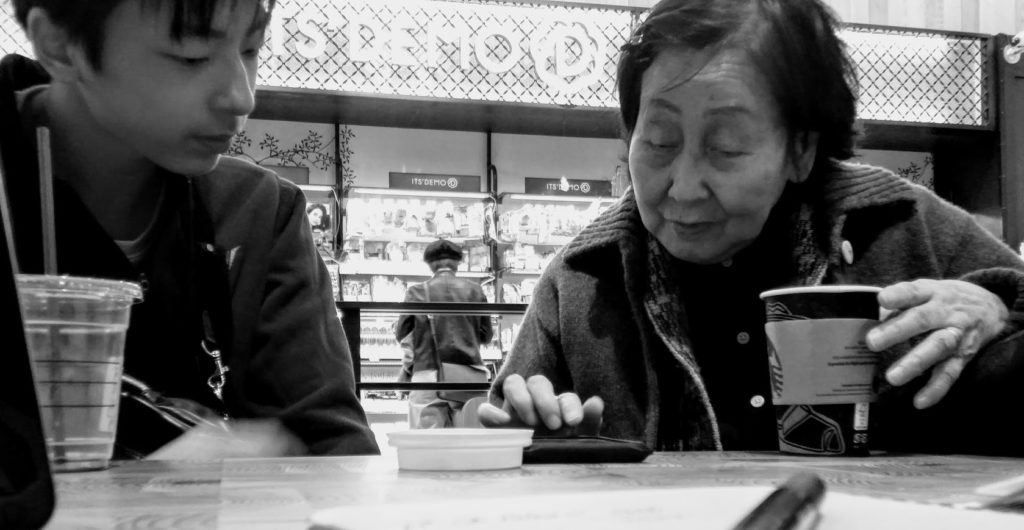
I love being in Japan but feel awkward and clumsy especially among the women. I look like one of them, being born to Japanese parents in Canada, but I am not one of them. This becomes more apparent when I hang out with my Japanese friends here and move around in daily life.
When I first got to Tokyo, my friend Makiko took me out for a shopping spree for the ingredients to make 50 some recipes in two days for the photo shoot for the Canadian Vegan Recipes book being released in Japan in April 2018.
Makiko is super organized and prepared a binder of my recipes with all the shopping lists printed out I had sent her, and indications of what we needed to buy and where in Tokyo. This is without asking her and not being able to pay her for her help.
I could have hugged her right then, and instead fed her iced coffee to begin our journey. First of all, hugging is not part of the custom in Japan. I am a huggy person but I want to respect the culture and customs. Second, I love the iced coffee here that is popular to drink year-round and helped to overcome the jet lag and exhaustion from my travels.
As I spent the day with Makiko, I realized how chanto she is and I am not.
Chanto is a Japanese word that means to do something diligently, reliably, steadily, with concentration, carefully and properly. This can refer to your task at hand or interaction with others.
In my often quick and impatient mode to get things done, I can sometimes move around unconsciously and too quickly, being the opposite of chanto.
On a busy Saturday shopping day with the stores filled with people, there was no aggression or impatience from anyone I could see, from the people shopping to the staff. The shoppers went on with their business with small carts or baskets, picking up things consciously and carefully.
Makiko was carefully watching for things to buy and me, like a mother watching over a child. She made sure that I didn’t push anyone by mistake and warned me when my backpack would come close to someone or something. She would wait if there was someone else ahead of us to look at something and always made sure we shared the space.
If there is any question of who was there first, she gave the other person the right of way. It’s a “you first before me” culture and I believe this is one of the reasons 36 million people, the same population of all of Canada, can live harmoniously in one city.
I found that shopping with Makiko became a mindfulness practice for me.
I became calmer and more considerate as the day went on, helping people when needed, going around people or taking another aisle so as not to disturb the person figuring out what to buy, letting the elderly or parent with children go first, and making enough space always for others.
At the supermarket check out, the staff person would greet me with a big smile, and hold up each item to tell me what it is and what the price is as he/she would put it in a basket.
I would take my baskets to be packed in another spot that is reserved for this. I saw that most people had little in their baskets for a Saturday afternoon shopping outing. I felt like a big shopper and was embarrassed with my two baskets overloaded with things. I felt like telling people this is not all for me but a photo shoot to explain but didn’t of course.
It was a great help to have Makiko with me throughout the day. I can get by with my broken spoken Japanese but I can only read the first alphabet hiragana, some katakana for foreign words, and about 50 kanji, which has thousands of characters and is similar to the Chinese alphabet.
In fact, the Japanese Ministry of Education provides an official list of the 2,136 kanji, known as jōyō kanji, that all students graduating from high school must know and is required to be fluent enough to read newspapers and literature in Japanese. If you ever wondered how the Japanese have such good memories and are so precise and patient, take a look at their language!
When I tried to buy products through the letters I did know and pictures, Makiko would often come to my rescue to make my life easier and help me decipher between the hundreds of kinds of miso paste, soy sauce or rice so I could come to the right decision based on what taste I wanted, size, and price.
Seeing chanto in action on my first shopping trip in Tokyo inspired me to practice it more often, especially in public. Chanto is not just a word for the Japanese but a way of life and being.
Each day I become more chanto in public, in particular, less self-conscious about myself and more conscious of others. In doing this, I feel I am touching my Japanese roots, hidden deeply in the ground like seeds, and nourished by these actions.
Also published on Medium.






0 Comments